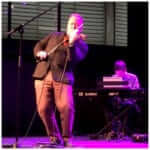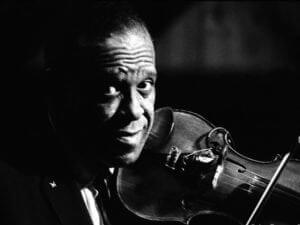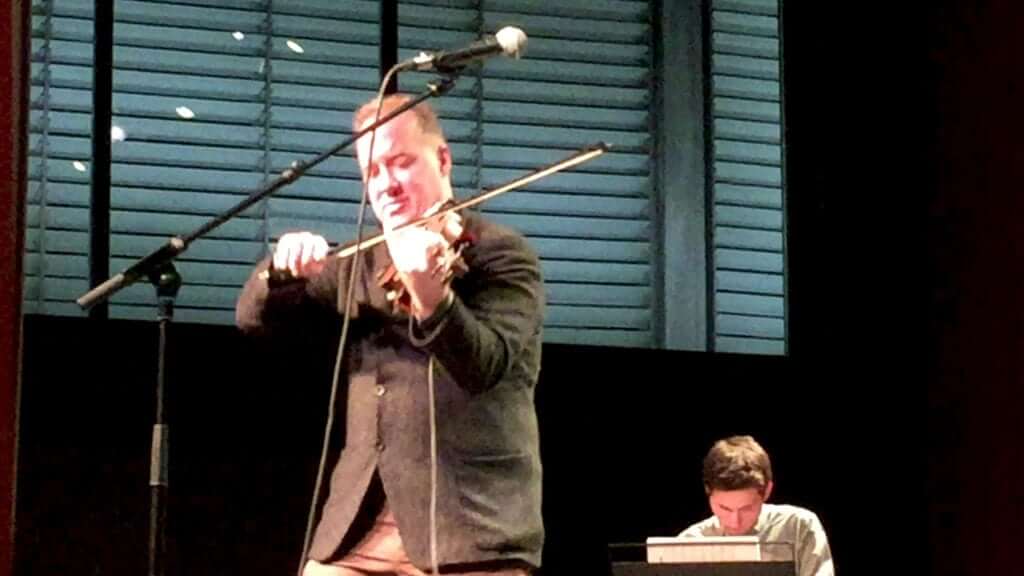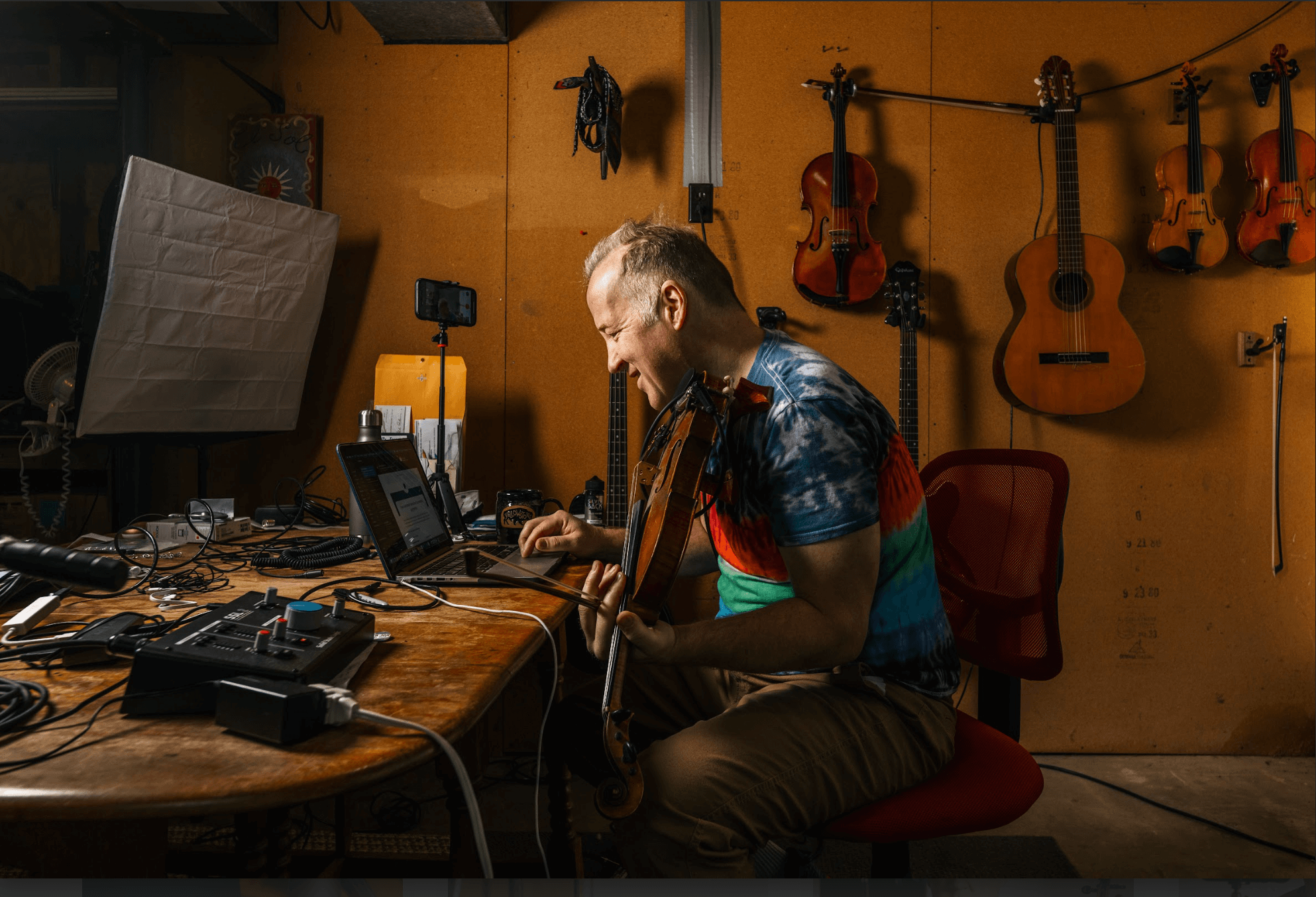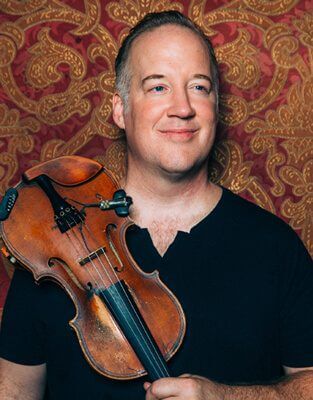Table of Contents
Blues Violin Improvisation- Live recorded solo from the 2018 Barcelona Fiddle Congress, and an essay on a need to change the culture of classical music education.
Read my essay below on why the subject of Blues Violin improvisation goes deeper than the surface for classical musicians.
I became interested in playing Blues on the violin around 1990 while playing bass with Ronnie Taylor, a blues singer in Columbus, Ohio.
I was an 18 year-old sophomore in college. One night after a gig someone told Ronnie I played violin and he asked me to pull it out and play a blues violin improvisation. He lit up and told me, “You should do that.” I felt encouraged. Up until then, I had only experimented with playing rock music on the violin (aside from my classical repertoire).
Two years later, when I went to prison on a drug charge, I started to think more about how I would like to study and be able to express myself through blues violin improvisation.
During those four years in Ohio prisons, whenever I wasn’t practicing alone on the yard, I played music with other convicts. Some, mostly white, played country, bluegrass, or rock music. Others, mostly black, played gospel, hip hop, R&B, or Jazz.
Playing in church services on Sundays had a totally different vibe than what I knew from recital halls or the white bars on Ohio State University campus. I thought, “I wonder why Black music is hardly ever played on the violin?” I realize now that it’s because the culture of education around learning the violin is segregated from and different than the way music is experienced and passed on in African-American culture.
The ways in which we experience music are colored by our cultural environment.
If we have not experienced something in a specific cultural environment, we have not experienced that thing. When it comes to the Blues, one cannot divorce the Blues from African American culture.
When I was listening or jamming on the yard, musicians would sometimes school me about Black music and culture. Those lessons continued after I left prison with musicians who would teach me through conversations or by the way they played on the band stand.
One time in the joint I remember Dave Turner taught me how to do a two-step. He told me to just keep working on that two-step. “It’s a feel thing,” he said. “Keep working on it.”
That two-step was frustrating to me. There’s a surface level simplicity about it but a deeper level invisibility about about how to do it right…
Like playing a back beat groove on a drum kit.
Or playing a simple swing rhythm on a hi hat.
Anyone can do it, but not anyone can do it right, make it feel right.
This is comparable to studying the blues.
Academia teaches the blues in surface-level academic ways.
Academia is a framework we can use to try to understand the blues, since the cultural source of the music is invisible to us. I’ll get to that. But what’s more important is to first appreciate the concept of invisibility, to acknowledge that many things are invisible to us. One of these things is the blues.
A lot of reading can not begin to make up for the fact that I am not privy to the Black experience.
Watching Showtime at the Apollo, Soul Train, and Spike Lee movies, and listening to tons of recordings from Black musicians can only help so far.
Jamming on the prison yard can only go so far.
Ultimately, I can study Black music for a lifetime and I will never truly be able to say that the experience and the music is visible to me.
But there are differing levels of visibility and invisibility, and anyone can learn more about anything.
So I say, to musicians trained in the western European tradition, “Go to the source.” Everyone in Jazz Academia says that… but when we begin to consider what it really means to Actually go to the source, we are confronted with the reality of segregation and racism in our world, and by how we are complicit in it.
If there’s anything a convict learns about human nature, it’s that we are all capable of being Hard when things are hard, and we tend to become Soft when things get easy. It’s easier for most people to stay on their side of the tracks, especially when their side has a nice coffee shop. It’s easier for people to ignore or pass over the work that it takes to appreciate something foreign or new.
Going to the source is more than listening to recordings, watching TV shows and movies, or observing from the comfort of a suburban enclave. Playing music with Black musicians, learning music in a Black space, and in other ways connecting in Black cultural contexts (church, neighborhoods, et al.), are important ways to connect more fully to the concept of what it means to play Black music. And a big part of the music is connected to the Blues.
At the same time, it’s important that white people be aware of our positionality in black spaces, and recognize when we should not be in a space. We are not entitled to participate in all spaces.
I’m not an expert on Black music; I’m not representing or writing this for African Americans.
I should not be the only frame of reference for such a vast subject, and it’s important to consult black voices and perspectives.
However it is important that I use my credibility with my audience to speak to classical musicians, specifically, about the concept of invisibility.
Once we accept that something is invisible to us, we can listen and look more deeply. And that’s when we can begin to appreciate, understand and connect with something or someone.
This is an area where classical musicians can change the culture of music education and impact culture at large.
More on this below. But first, I’ll address the topic of blues violin improvisation from an academic/instructional standpoint, the best way I know how.
Here are some ways, albeit imperfect, in which I would present the subject matter of “Blues Violin Improvisation” to a typical orchestra class or classical string player:
Historical– Tracing to slavery (spirituals, work songs, and blues)
Cultural– Addressing questions of cultural proprietorship
What is the Blues? Blues can be understood in terms of song and literary form, but also as an existential and unexplainable phenomenon. To be “blue” is equated with sadness, but a fuller understanding of Blues in it’s rich African American cultural heritage is to recognize that it expresses/reflects the paradox of joy and suffering in life. “The Blues” can be observed throughout the past 200 years in many expressions of African American culture and art. Literature, dance, music, fashion, and more…
Literary Form– A 12-bar blues has the form of: “A- A1- B” – three phrases. These can be understood via literary (words) means. For example, writing or composing a blues using only words, without rhythm, harmony, or pitch. (For that matter, refer to Gwendolyn Brooks, Langston Hughes, Zora Neale Hurston, or any number of great African American writers who have employed blues in literature.)
Melody– A 12-bar Blues melody mimics the literary form in terms of simple melodies, i.e. “A- A1- B”. A common problem in blues violin improvisation for beginners is the confusing of ornament for melody. A proper melody should conform to the simple structure above. Ornament should serve to reinforce the key structural melody.
Harmony– The use of 1- 4- and 5 in variations of blues form. Harmonic rhythm.
Ornamentation– Again, a classic mistake of beginners in blues violin improvisation is to confuse ornamentation with statement. A blues has as its basis the A- A1- and A2 “statements.” Ornamentation is added to bring richness, much in the way the preacher augments a message to the congregation within a participatory, call and response environment
Blues Scales– We can understand blues violin improvisation by first using one blues scale, and ultimately by mixing two blues scales (derivatives of pentatonic scale). Unfortunately this is often the only thing taught, without regard for many other components in this outline. Many musicians make a mistake when they only apply the minor blues scale from the tonic chord in a blues progression. A deeper approach is to mix BOTH the major blues scale AND the minor blues scale (both derived from the tonic chord), throughout the progression.
Clave/Groove/Rhythm– Blues often has a pulse. The pulse in African-derived music is more important than the melody or harmony (vs Western music).
The Triplet -is an essential basis of the “swing” which colors much of Blues music. Developing fluency with triplets for a classical musician is like strengthening the left arm for a right handed person.
Oral Tradition– As opposed to written.
Participatory / Call and Response vs Discursive– Quoting Gunther Shuller (paraphrase):
“To compare Mozart to the Blues is to compare Lincoln giving the Gettysburg address to Richard Pryor and Eddie Murphy having a verbal sparring contest on a street corner.”
My overview syllabus above, (which I break down in workshops on blues violin and in my course on blues violin improvisation) are a means to discuss the topic, but they should only be considered in a larger context of respect for Black music and culture.
For classical teachers, I invite you to consider that, as in the penitentiary, whatever we do, or don’t do, can be interpreted as standing for something, one way or another.
The improvement of our field (music education) starts with an acceptance of what we don’t see, what we don’t know, and what we don’t understand.
This classical music education community, which I love, and from which I was bred, with it’s curriculum, degree tracks, pedagogy, repertoire, all of which informs the archetype of the violin, is arguably #toowhite.
Our representation and ideas are limited by a perspective which fails to reflect the diversity and depth of ideas related to:
a) What music IS
b) Values correlated with musicianship
c) Ways of knowing and teaching music
d) Frameworks for presenting/sharing music
If we want to have any part of changing culture at large, we can begin within our own classical music community.
By separating classical music from other styles of music, our educational systems are reinforcing segregation, notions of cultural superiority and otherness, and marginalization in society at large. The goal of a multicultural agenda should be a driving force behind the thinking as it pertains to any curriculum, pedagogy, or conversation related to music.
We should continue to welcome other people into classical music. We also need to open ourselves outside the confines of our gated community, into vulnerable unknowns beyond our training and experience. It begins with acknowledging the blind spots within our educational culture, having respect for whatever is invisible to us, and engaging in deeper listening.

